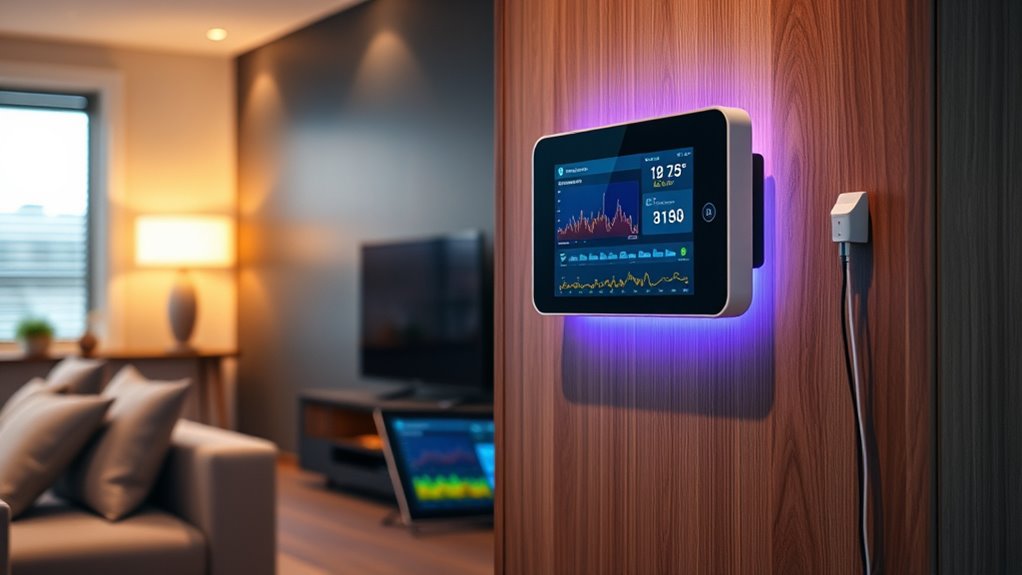If you’re looking to track and cut your energy costs, there are several top smart monitors I recommend. Devices like the Siemens Inhab and Emporia Gen 3 offer precise, real-time data at the circuit level, helping you identify high-energy appliances. Smart plugs from TP-Link and heavy-duty options also provide control and insights. Each tool has unique features, so exploring the options can help you find the perfect fit. Keep going to discover which monitors suit your needs best.
Key Takeaways
- Choose monitors with high accuracy (±2%) and real-time data to reliably track household energy consumption.
- Opt for devices supporting multiple circuits and solar tracking for comprehensive energy management.
- Prioritize models with home automation integration (Alexa, Google, Zigbee, Z-Wave) for seamless control and automation.
- Consider installation complexity, ensuring compatibility with your electrical system and professional wiring needs.
- Look for features like peak demand management, load shedding, and detailed app interfaces to optimize savings and monitoring.
SIEMENS Inhab Smart Home Energy Monitor

If you’re looking for a thorough energy monitor that provides detailed, real-time insights at both the home and circuit levels, the Siemens Inhab Smart Home Energy Monitor is an excellent choice. It installs directly in your electrical panel, measuring energy use at mains and up to 16 circuits with precision. The system supports features like Time of Use Management, Peak Demand, and solar excess control, all reported to a mobile app. It’s compatible with US and Canadian standards, offering clear data on consumption and generation. While installation requires a licensed electrician, its detailed monitoring helps optimize energy use, reduce costs, and improve efficiency.
Best For: homeowners and energy enthusiasts seeking detailed, real-time circuit-level energy monitoring to optimize efficiency and manage solar and demand features.
Pros:
- Provides precise, real-time monitoring of energy consumption at both mains and individual circuits.
- Supports advanced features like Time of Use Management, Peak Demand, and solar excess control.
- Compatible with US and Canadian electrical standards, with user-friendly mobile app for data analysis.
Cons:
- Installation requires a licensed electrician, which can add to upfront costs.
- Limited to 16 sensors, which may be insufficient for larger or more complex panels.
- App export process can be cumbersome, and some data spikes may occur in logs.
Emporia Gen 3 Smart Home Energy Monitor
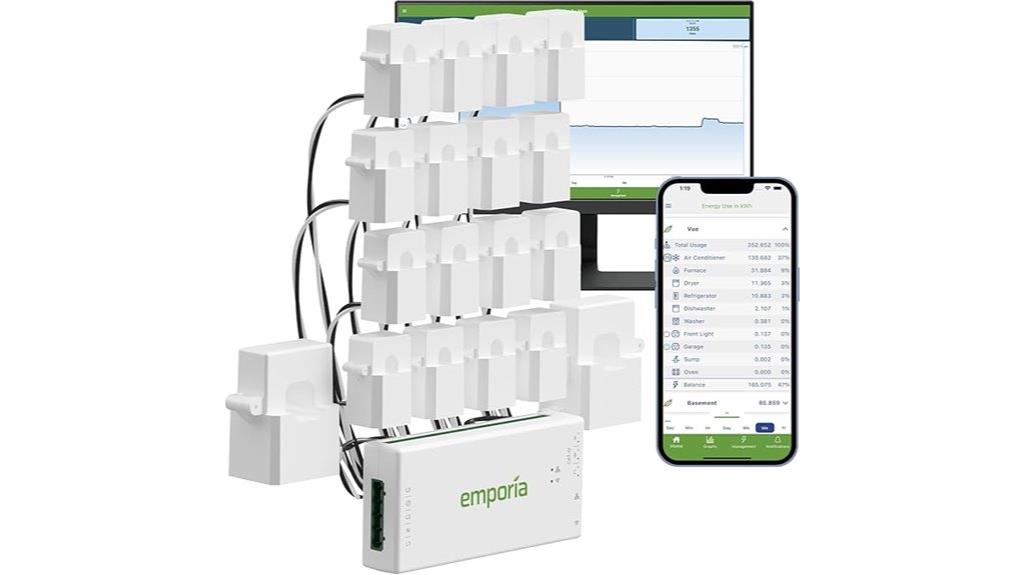
The Emporia Gen 3 Smart Home Energy Monitor stands out for its precise circuit-level monitoring, making it ideal for homeowners who want detailed insights into their energy use. It supports up to 16 50A sensors and various electrical systems, with safety certifications like UL and CE. The device provides real-time data via WiFi, with ±2% accuracy, and stores historical data for analysis. Installation is straightforward for those comfortable with electrical work, and the app offers actionable insights to optimize energy consumption. Overall, it’s a reliable, detailed tool that helps track and reduce energy costs, especially when integrated with platforms like Home Assistant.
Best For: homeowners seeking detailed, circuit-level energy monitoring to optimize their energy use and reduce costs with advanced data insights and automation capabilities.
Pros:
- High accuracy within ±2% of utility readings, providing reliable data for energy management
- Supports a wide range of electrical systems and up to 16 sensors for comprehensive monitoring
- Integration with smart home platforms like Home Assistant for automation and enhanced control
Cons:
- App interface considered dated and less intuitive compared to competitors
- Installation requires familiarity with electrical wiring, which may be challenging for some users
- Limited automatic handling of split-phase loads and lack of specific Canadian TOU rate support
Smart Home Energy Monitor with Circuit Sensors and Real-Time Energy Tracking

For homeowners and energy enthusiasts seeking precise, real-time tracking of their electricity use, the Smart Home Energy Monitor with circuit sensors stands out as an excellent choice. It offers 98% accuracy with 16x60A and 2x200A sensors, compatible with various electrical systems. Easy to install in most panels, it includes everything needed for setup and supports solar and renewable energy monitoring. The device provides continuous data on power, current, voltage, and power factor through the Refoss app. Smart alerts help detect unusual consumption spikes, enabling better management and savings. Its detailed charts and privacy-focused local data storage make it a reliable tool for optimizing energy efficiency at home.
Best For: homeowners and energy enthusiasts who want precise, real-time monitoring of their electricity consumption and energy management.
Pros:
- Highly accurate energy tracking with 98% precision across multiple circuits
- Supports solar and renewable energy monitoring for cost savings and efficiency
- User-friendly app with detailed charts and smart alerts for proactive energy management
Cons:
- Installation requires professional expertise due to electrical safety and complexity
- Manual setup can be challenging, especially with clamp orientation and double-pole breakers
- App display may have limitations with certain circuit configurations, such as wattage readings on double-pole breakers
Smart Home Energy Monitor with 16 Circuit Level Sensors
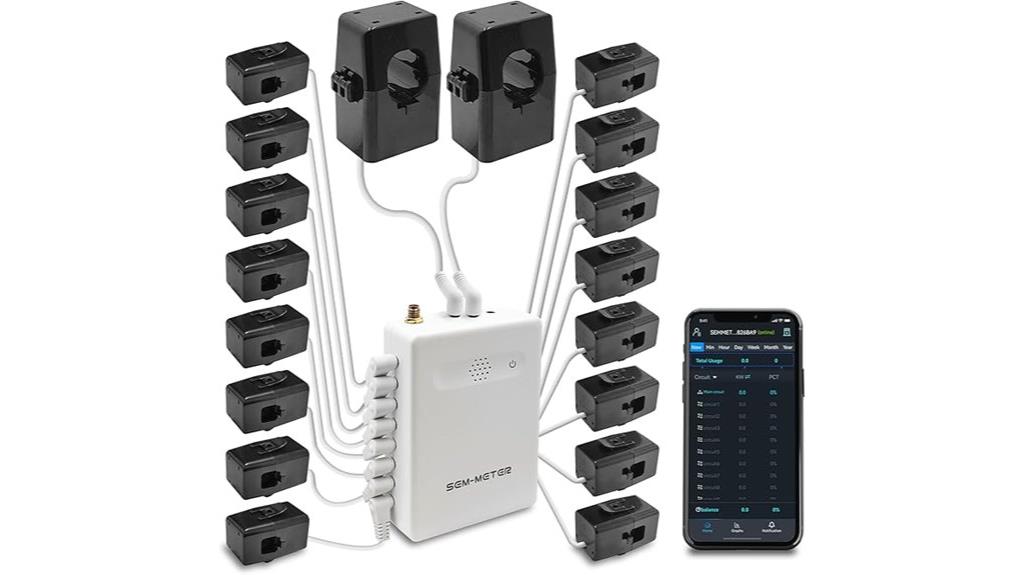
A smart home energy monitor with 16 circuit level sensors offers precise, granular insight into power usage across multiple circuits, making it ideal for homeowners seeking detailed energy data. It features 16 50A sensors that measure real-time power consumption and provides historical data through an intuitive app. Compatible with Home Assistant, MQTT, and local LAN operation, it eliminates cloud dependency. Installation is straightforward with clamp-on sensors, and it supports single-phase, split-phase, and three-phase systems up to 415Y/240VAC. With detailed graphs, load balancing, cost estimates, and alerts, it helps identify high-power appliances and optimize energy use for savings.
Best For: homeowners and technical users seeking detailed, circuit-level energy monitoring to optimize energy efficiency and reduce costs without reliance on cloud services.
Pros:
- Provides highly granular, real-time power usage data across 16 circuits with high accuracy.
- Compatible with popular home automation platforms like Home Assistant and MQTT, supporting local LAN operation.
- Easy to install with clamp-on sensors and comprehensive documentation, suitable for various electrical systems including single-phase, split-phase, and three-phase setups.
Cons:
- Installation can be challenging for some users, especially in complex or hard-to-access breaker panels.
- Requires configuration adjustments for certain circuits, which may need technical knowledge.
- Limited to 16 sensors without the option for additional expansion beyond 8 extra sensors, potentially limiting scalability for very large systems.
Smart Home Energy Monitor with 16 50A Circuit Level Sensors

If you’re looking to monitor multiple circuits with precision, the Smart Home Energy Monitor featuring 16 50A circuit sensors stands out as an ideal choice. It measures real-time power usage and provides detailed historical data through an easy-to-use app. Compatible with Home Assistant, MQTT, and capable of local LAN operation, it doesn’t rely on cloud services. Designed for single-phase, split-phase, and three-phase systems up to 415Y/240VAC, it’s suitable for diverse electrical setups. The compact clamps make installation straightforward, and optional flexible sensors help access busbars. With a 1-year warranty and support for solar and net metering, it’s a robust solution for all-encompassing energy monitoring.
Best For: homeowners and energy enthusiasts seeking precise, comprehensive, and customizable energy monitoring across multiple circuits without relying on cloud services.
Pros:
- Accurate measurement of real-time power usage with 1.5% precision
- Compatibility with popular home automation platforms like Home Assistant and MQTT
- Easy installation with compact clamps and support for various electrical systems, including single-phase, split-phase, and three-phase setups
Cons:
- Installation can be challenging for some users, especially in complex panels
- Limited to systems up to 415Y/240VAC, not suitable for Delta configurations
- Requires optional flexible sensors for busbar access, which may involve additional purchase and setup steps
Smart Home Energy Monitor with Circuit Sensors and Real-Time Tracking
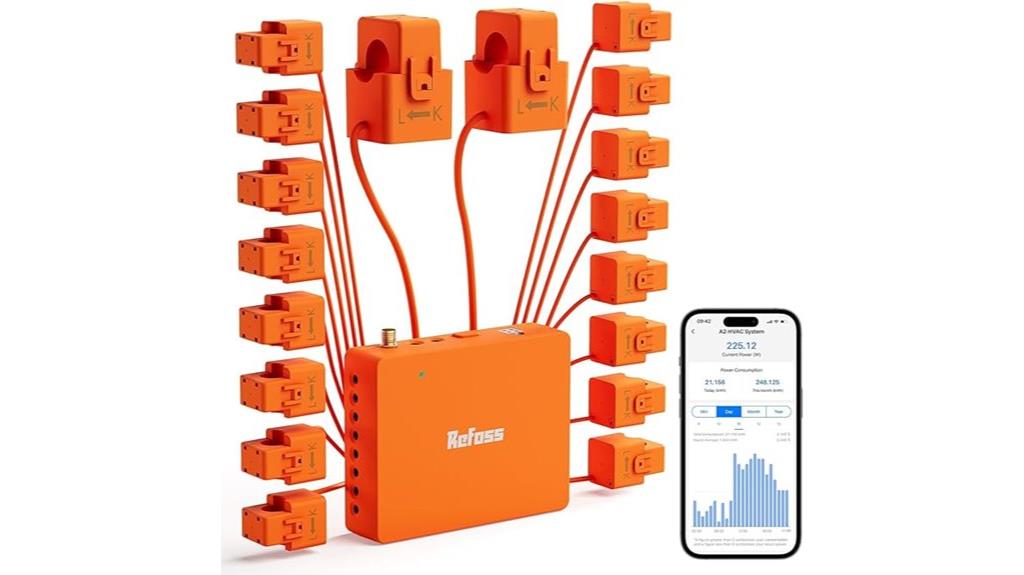
The Smart Home Energy Monitor with Circuit Sensors and Real-Time Tracking stands out as the ideal choice for homeowners and small businesses seeking precise, continuous energy monitoring. It offers 98% accuracy with 16x60A and 2x200A sensors, compatible with various electrical systems, and supports solar and renewable energy tracking. Installation requires a licensed electrician, but the device provides detailed data through the app, including power, current, voltage, and power factor. Real-time alerts help optimize usage, saving users 10-20%. Its local data storage guarantees privacy, and firmware updates add features like inverting readings, making it a reliable, versatile tool for energy management.
Best For: homeowners and small businesses seeking precise, real-time energy monitoring and management to optimize energy use and reduce costs.
Pros:
- High accuracy with 98% precision across multiple circuits and energy sources
- Supports integration with renewable energy systems like solar and wind turbines
- Local data storage ensures privacy and detailed long-term consumption insights
Cons:
- Installation requires a licensed electrician due to complexity and safety risks
- Manual setup can be challenging, especially for double-pole breakers or limited panel space
- Some app display limitations for specific circuit types, such as double-pole 240V breakers
TP-Link Tapo Smart Plug Wi-Fi (4-Pack)
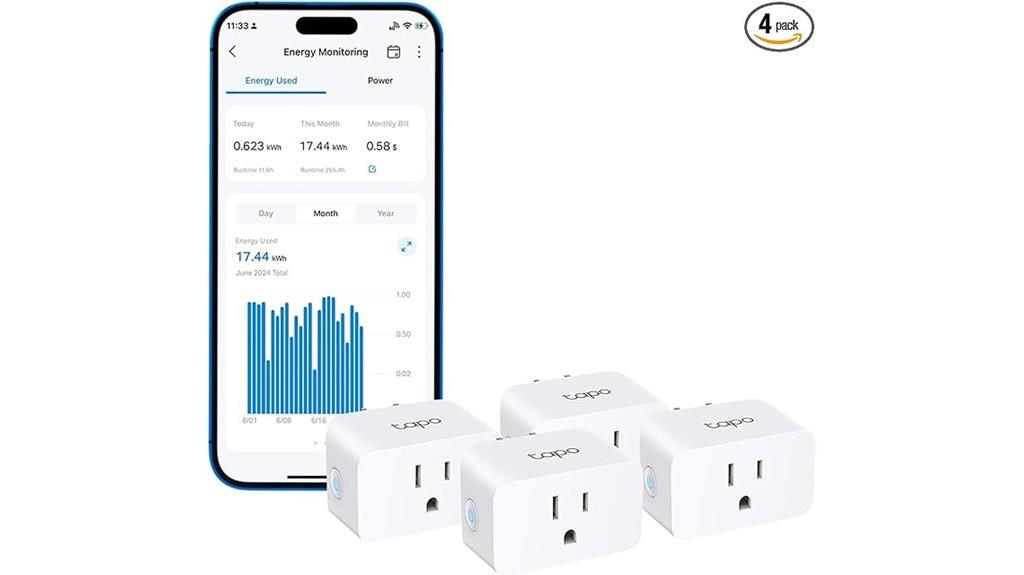
TP-Link Tapo Smart Plug Wi-Fi (4-Pack) stands out for its all-encompassing energy monitoring features, making it ideal for anyone looking to track and optimize their household power consumption. It provides detailed energy usage stats, intuitive charts, and historical data, helping you estimate bills and identify savings opportunities. With programmable schedules, timers, and real-time power tracking, you can automate device operation based on sunrise, sunset, or custom times. The plugs also include surge protection, auto-shutoff, and safety features like charge guard, all controllable remotely via the Tapo app. Easy setup and reliable connectivity make this a practical choice for smarter energy management at home.
Best For: homeowners and energy-conscious users seeking comprehensive power monitoring, automation, and safety features to optimize household energy consumption.
Pros:
- Offers detailed energy usage statistics, charts, and historical data for better cost management
- Supports programmable schedules, timers, and real-time power tracking for automation and efficiency
- Includes safety features like surge protection, auto-shutoff, and charge guard for device safety and reliability
Cons:
- Slightly bulky design may block adjacent outlets, limiting placement options
- Limited to 2.4 GHz Wi-Fi, which may affect connectivity in some networks
- Higher price point compared to some competing smart plugs with fewer features
Emporia Gen 3 Smart Home Energy Monitor
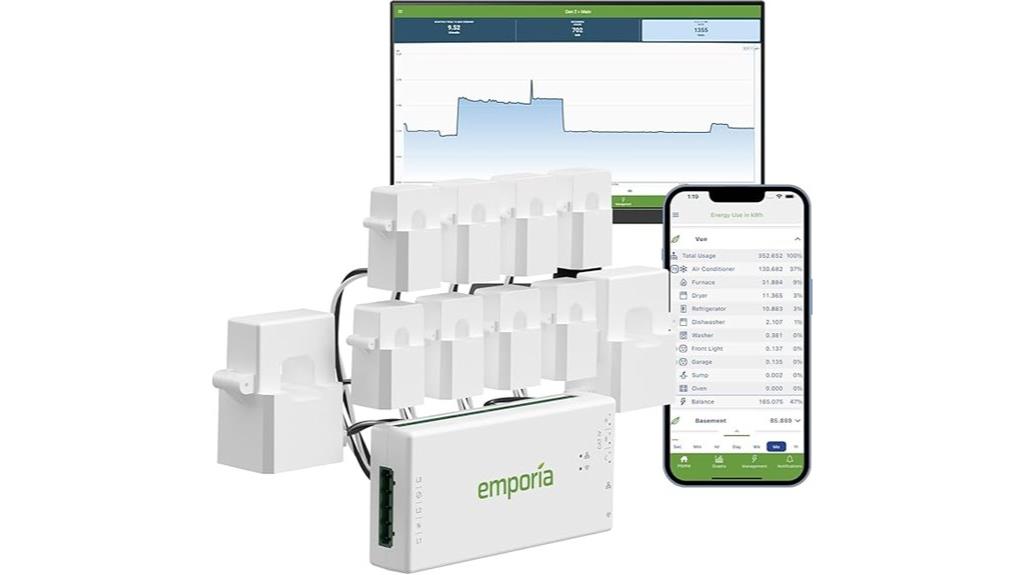
Designed for homeowners seeking precise, circuit-level energy monitoring, the Emporia Gen 3 stands out as a reliable choice. It supports up to eight sensors across various electrical systems, including single-phase and three-phase setups, with UL certification ensuring safety and durability. Installation is straightforward—just clamp the sensors inside your panel, typically in about 15 minutes—though electrical knowledge is recommended. The system offers real-time data with ±2% accuracy, accessible via Wi-Fi through a user-friendly app. Many users report significant savings by identifying high-energy devices and optimizing their usage, making the Emporia Gen 3 a powerful tool for smarter energy management.
Best For: homeowners seeking precise, circuit-level energy monitoring and cost-saving insights with easy installation and reliable real-time data.
Pros:
- Supports multiple electrical systems including single-phase and three-phase setups for versatile installation
- Certified UL safety standards ensuring durability and protection against hazards
- Provides highly accurate energy data (±2%) with real-time updates and cloud storage
Cons:
- Installation can be challenging in older or crowded electrical panels requiring electrical expertise
- App interface may feel dated and lacks advanced features like pinch-to-zoom or combined circuit views
- Long-term data access depends on Emporia’s cloud service, raising concerns about future access and potential subscription fees
SIEMENS Inhab Smart Home Energy Monitor

If you want detailed, circuit-level energy monitoring that helps optimize your home’s power use, the Siemens Inhab Smart Home Energy Monitor stands out as an excellent choice. It installs directly in your electrical panel, measuring energy consumption at mains and up to 16 circuits with high accuracy. The system supports real-time data reporting via a user-friendly app, providing insights into overall and individual circuit usage. Advanced features like Peak Demand Management, Solar Monitoring, and Load Shedding help reduce waste and manage energy costs effectively. While installation requires a licensed electrician, the system’s detailed data and compatibility with North American electrical setups make it a powerful tool for energy-conscious homeowners.
Best For: homeowners and energy-conscious users seeking detailed, circuit-level energy monitoring and management in North American electrical systems.
Pros:
- Provides highly accurate real-time energy and demand data at both mains and individual circuits.
- Supports advanced energy management features like Peak Demand Control and Load Shedding.
- Easy-to-use mobile app with detailed charts and data export options for analysis.
Cons:
- Installation requires a licensed electrician due to electrical safety and wiring complexity.
- Limited to 16 circuit sensors, which may be insufficient for larger or complex panels.
- App setup and data export processes can be somewhat cumbersome, with occasional data spikes.
Sense Energy Monitor, Real-Time Electricity Usage Tracker
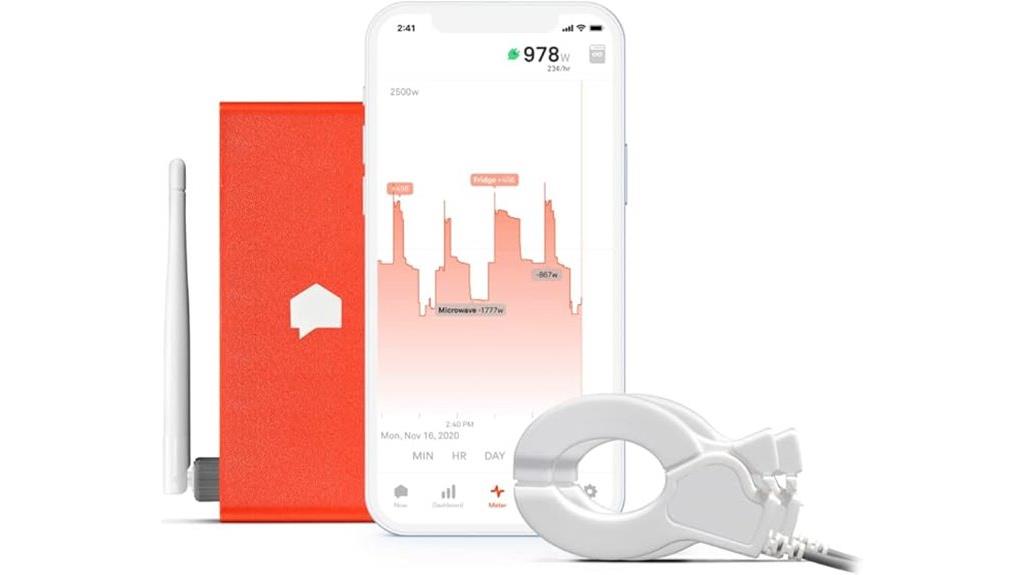
The Sense Energy Monitor stands out as an ideal choice for homeowners seeking real-time insights into their electricity usage. It tracks energy consumption instantly, helping you identify patterns and manage costs effectively. With support for custom alerts, you can monitor critical devices like sump pumps or water heaters remotely via iOS, Android, or web apps. Installation takes about 30 minutes but should be done by a licensed electrician for safety. Although it’s only available in North America, it’s a reliable, user-friendly device that provides accurate data—roughly 5-10% off compared to utility meters—making energy management simpler and more efficient.
Best For: homeowners and property managers seeking real-time energy monitoring and cost management with remote alerts and device detection.
Pros:
- Provides instant, real-time insights into home energy consumption for better management.
- Supports remote monitoring and custom notifications for critical devices via multiple platforms.
- Easy installation (about 30 minutes) and meets safety standards for indoor electrical panel use.
Cons:
- Only available in North America, limiting international options.
- Slight discrepancy (5-10%) compared to utility meters, which may require calibration for precise billing.
- Compatibility limited to standard North American electrical setups, with no support for complex billing schemes in some regions.
Smart Home Energy Monitor with 2 CTs and Wi-Fi
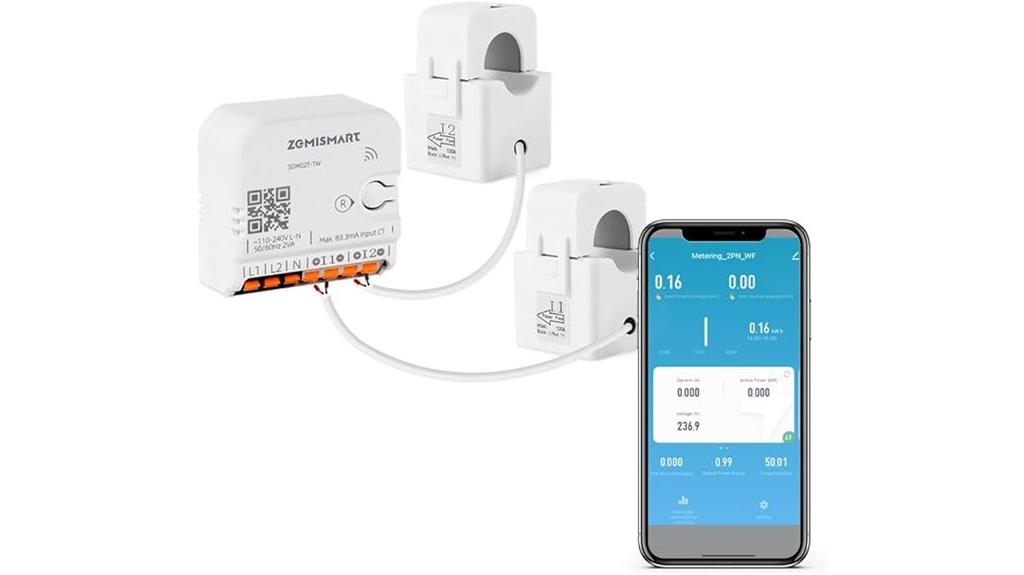
For homeowners seeking precise and real-time energy tracking, the Smart Home Energy Monitor with 2 CTs and Wi-Fi offers an excellent solution. It features two 120A split-core CTs, providing accurate voltage, current, power, and energy data for single-phase 3-wire systems. Supporting solar and battery setups, it measures household consumption and grid export with Class 1 accuracy. Easy to install with pluggable terminals and compact CTs, it connects via 2.4GHz Wi-Fi and integrates with the Smart Life app. This monitor enables real-time analysis, alerts, automation, and load balancing, helping you optimize energy use and reduce costs effectively.
Best For: homeowners and energy enthusiasts seeking accurate, real-time monitoring and automation for their solar, battery, and grid energy management systems.
Pros:
- Supports precise Class 1 accuracy for solar and grid export measurements
- Easy to install with pluggable terminals and compact split-core CTs
- Compatible with smart home automation platforms like Smart Life, Home Assistant, and Z2M
Cons:
- Initial app pairing can be challenging, requiring troubleshooting steps
- Limited to single-phase 3-wire systems, restricting use in multi-phase setups
- Slightly higher cost compared to basic energy monitors with fewer features
Kasa Smart Plug Mini with Energy Monitoring
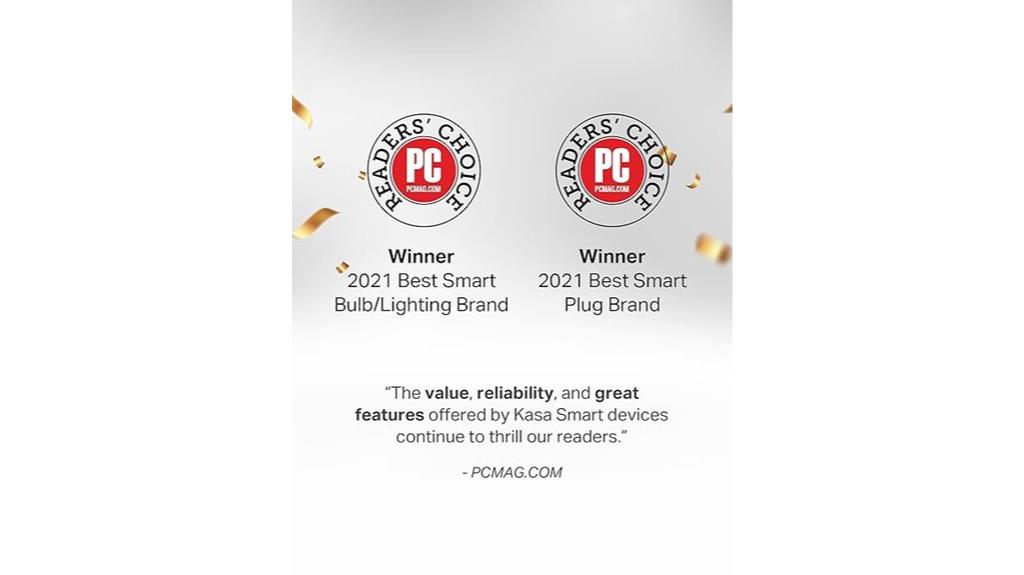
The Kasa Smart Plug Mini with Energy Monitoring stands out as a top choice for anyone seeking a compact, easy-to-use device that offers real-time energy insight and remote control. With Wi-Fi connectivity and compatibility with Alexa, Google Home, and IFTTT, it’s versatile for voice commands and app control. It’s simple to set up—plug in, connect via the Kasa app, and start monitoring power usage, schedules, and device control from anywhere. Designed in Silicon Valley, it’s trusted by over 5 million users and features safety protections like overheating prevention and a fireproof shell. Its small size leaves room for other outlets, making it a practical addition to any smart home.
Best For: smart home enthusiasts seeking a compact, reliable, and energy-monitoring smart plug that integrates easily with voice assistants and offers remote control.
Pros:
- Easy setup with intuitive app interface and reliable Wi-Fi connectivity
- Compact design that leaves other outlets free for use
- Built-in energy monitoring with safety features like overheating protection and fireproof shell
Cons:
- Kasa app does not allow resetting energy usage data without third-party apps
- Occasional network connection issues that may require reconfiguration
- Limited control over energy data within the official app, requiring workarounds for full functionality
2 Pack Watt Meter Power Monitors for Home Energy and Electricity Usage
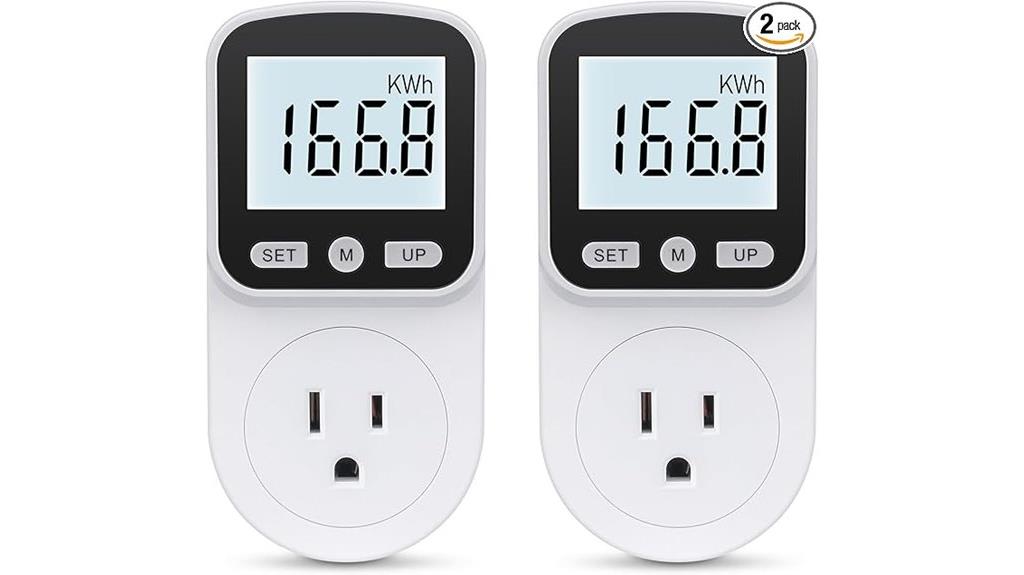
Two-pack watt meter power monitors stand out as a practical choice for homeowners looking to track multiple electrical parameters at once. These devices measure power (W), electricity usage (kWh), voltage, current, frequency, power factor, and cost, with eight display modes for detailed insights. They feature overload protection, alerting you if an appliance exceeds 1800W, and have a durable ABS body for safety. The LCD backlight ensures visibility day or night, and data is stored even during outages. Resetting is simple, making it easy to manage your energy consumption. Overall, these monitors offer thorough, user-friendly energy tracking to help you save effectively.
Best For: homeowners and energy-conscious individuals seeking an easy and comprehensive way to monitor and manage their household electricity consumption and costs.
Pros:
- Tracks multiple electrical parameters including power, voltage, current, and cost for detailed energy insights
- Equipped with overload protection and durable ABS body for safety and longevity
- Easy data management with automatic data saving during outages and simple reset functions
Cons:
- May require familiarity with electrical parameters for optimal use
- Limited to US-compatible sockets and plugs, not suitable for international outlets
- Backlight activation depends on connection to AC power and manual toggle, which might be inconvenient in some situations
EMPORIA Smart Plug with Energy Monitoring (Package of 4)

If you’re looking to manage multiple devices effortlessly and monitor their energy consumption in real time, the EMPORIA Smart Plug with Energy Monitoring (Package of 4) is an excellent choice. It connects via WiFi and works with Alexa and Google Assistant, allowing voice control in North America. You can schedule devices, like lamps or fans, to turn on or off automatically, and track power usage through the app. The plugs support up to 10A continuous load and can log detailed energy data, helping you identify waste and cut costs. Overall, it’s a reliable, user-friendly solution for smarter energy management across your home.
Best For: homeowners seeking easy remote control and energy monitoring of multiple household appliances using a WiFi-enabled, voice-compatible smart plug.
Pros:
- Supports remote control and scheduling via the Emporia App, enhancing convenience and automation.
- Provides real-time energy consumption data to help reduce electricity costs and identify wasteful devices.
- Compatible with Amazon Alexa and Google Assistant for voice control, simplifying operation.
Cons:
- Some users experience unreliable scheduling, with about 50% chance of correct device operation.
- Limited to 10A continuous load, restricting use with high-power kitchen appliances.
- WiFi connection issues may occur if the device is placed too close to routers or if the network is unstable, requiring reconfiguration.
25A Heavy Duty Smart Plug with Timer, Energy Monitor, Voice Control, WiFi, SD Card Storage, Overload Protection, and Real-Time Usage Tracking
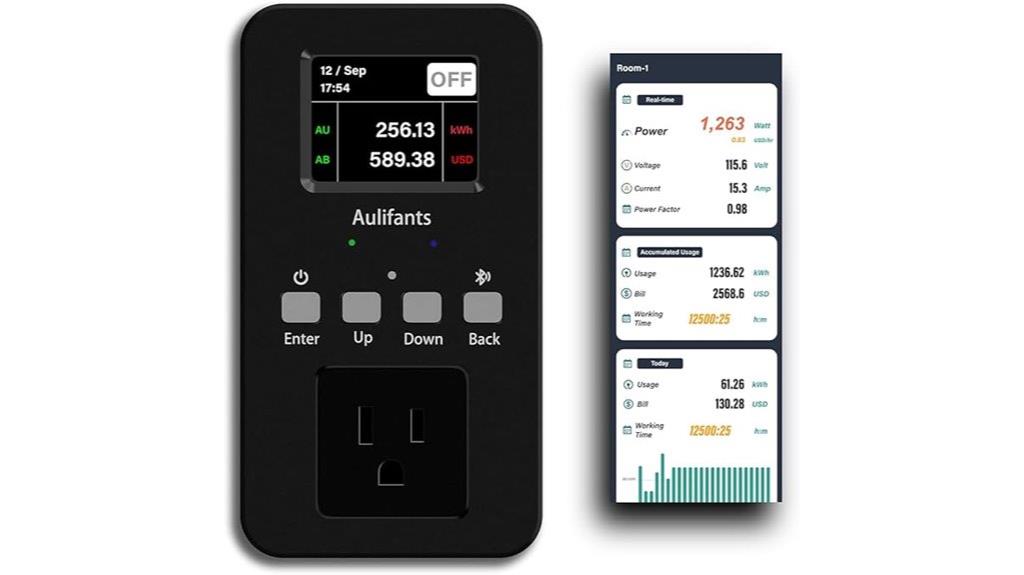
For homeowners who need to safely power and monitor high-wattage appliances, this heavy-duty smart plug offers an ideal solution. It supports up to 25A and 5500W, perfect for devices like heaters and AC units. Built with flame-retardant materials and overload protections, it guarantees safety and durability with a 100,000-cycle lifespan. The device features real-time energy tracking, including voltage, current, and power consumption, displayed on a bright TFT screen. It integrates with Alexa and Google Assistant for voice control, and its app allows scheduling, energy cost tracking, and usage limits. Despite some app connectivity issues, it’s praised for its robust performance and safety features.
Best For: homeowners and technicians needing a reliable, heavy-duty smart plug to safely control and monitor high-power appliances like heaters and air conditioners.
Pros:
- Supports up to 25A and 5500W, suitable for high-wattage devices.
- Equipped with real-time energy monitoring and data logging via SD card backup.
- Integrates with Alexa and Google Assistant for convenient voice control.
Cons:
- Some users experience difficulties with app pairing and connectivity.
- The app interface has small fonts and low contrast, affecting usability.
- Hardware issues such as stuck power buttons and protruding case parts have been reported.
Factors to Consider When Choosing Smart Home Energy Monitors to Track Usage
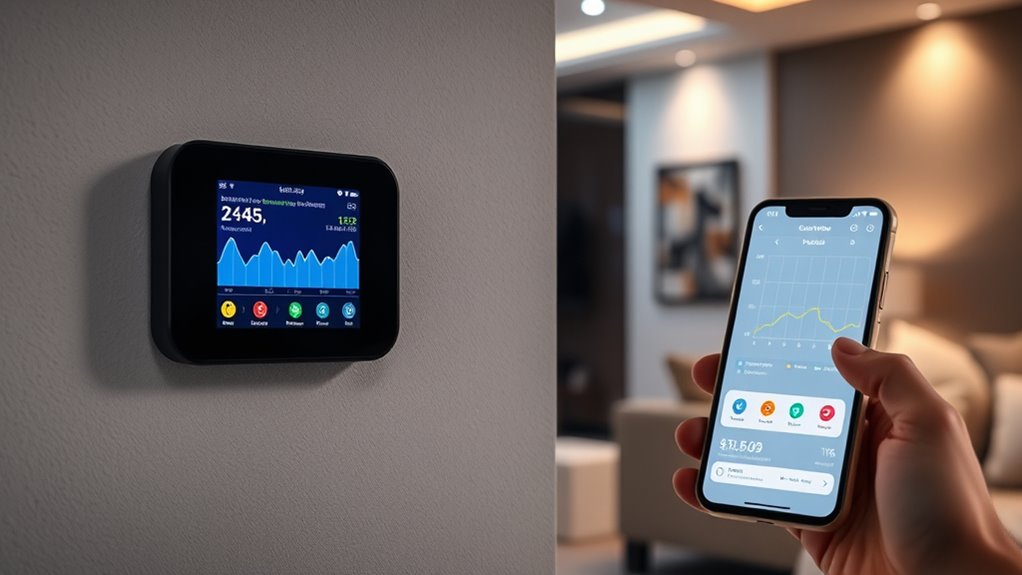
When choosing a smart home energy monitor, I look at how well it works with my existing systems and how easy it is to install. I also consider its sensor coverage, data accuracy, and the connectivity options it offers. These factors help guarantee the monitor fits my needs and provides reliable, detailed usage insights.
Compatibility With Systems
Selecting a smart home energy monitor that integrates smoothly with your existing setup is vital for effective tracking and automation. First, make sure it supports your smart home ecosystem, like Alexa, Google Assistant, or Apple HomeKit, so you can control and automate easily. Check if the monitor is compatible with your electrical system—single-phase, split-phase, or three-phase—to ensure accurate readings. It’s also important to see if it supports local control protocols like MQTT, Zigbee, or Z-Wave, especially if you want advanced or custom automation. Consider how the device connects—Wi-Fi, Ethernet, or both—based on your network setup and preferences. Finally, verify compatibility with any automation platforms or home management systems you already use or plan to add in the future.
Installation Complexity Level
The installation process for smart home energy monitors can vary widely, affecting how easily you can get your system up and running. Some monitors are plug-and-play, requiring no tools or professional help, making setup quick and straightforward. Others, especially those with circuit-level sensors, involve wiring current transformers (CTs) inside your electrical panel, which can take anywhere from 15 minutes to several hours depending on access and your familiarity with electrical work. Devices with modular components or customizable wiring might demand more technical skill. If you’re comfortable with electrical safety and have some DIY experience, installation could be manageable. However, more complex setups—like those with multiple sensors or intricate network requirements—may necessitate professional assistance to guarantee proper, safe installation.
Sensor Coverage Capacity
Evaluating the sensor coverage capacity is crucial to guarantee your smart home energy monitor can manage all the circuits you wish to track. You should confirm the monitor supports the maximum number of circuit sensors needed for your electrical panel, which typically ranges from 8 to 16 channels. Verify that its sensor capacity matches your panel’s breaker count to avoid extra devices or upgrades. Check whether the sensors are clamp-on for easy installation or require wiring modifications, especially for complex panels. It’s also wise to validate if the system allows expansion with additional sensors for future monitoring needs. Keep in mind, some monitors have a fixed channel limit, like 16 sensors, which may not suffice for larger or more intricate electrical systems.
Data Accuracy and Precision
Ensuring your smart home energy monitor provides accurate and precise readings is critical for reliable energy management. Devices that stay within 1-2% of your utility meter’s readings give you trustworthy data to analyze your usage effectively. High-quality current transformers (CTs) and correct installation are essential for precision, as poor placement can introduce errors. Consistency over time is also important; stable calibration ensures your data remains reliable long-term. Monitors with finer resolution, like 1-second interval logging, can capture quick load changes and power spikes more accurately. To verify accuracy, comparing monitor data against your utility bills or known loads helps confirm trustworthy measurements. Prioritizing these factors ensures you make informed decisions to save energy and reduce costs.
Connectivity Options Available
Choosing the right connectivity option is essential for seamless integration and reliable data access in your smart home energy monitor. Wi-Fi is popular for remote control and easy access through smartphone apps, making it convenient to monitor energy use from anywhere. If you prefer a low-power setup, Zigbee and Z-Wave offer mesh-network communication that works well with smart home hubs, ensuring smooth automation. Bluetooth monitors are suitable for short-range, local data transfer, often requiring proximity during setup and daily use. Ethernet-connected devices provide a stable, wired connection, reducing interference and latency, which is ideal for consistent, real-time data. Your choice depends on your existing smart home system, desired convenience, and the importance of a stable connection.
App Functionality and Ease
A user-friendly app interface makes managing your energy data much simpler. Clear, organized visualizations help you quickly understand your consumption patterns without confusion. Features like data export options in CSV or Excel formats allow for detailed analysis and tracking over time, making it easier to identify trends. Real-time notifications and alerts for unusual spikes keep you responsive and enable quick action to save energy. Compatibility with popular smart home platforms such as Alexa, Google Assistant, or Home Assistant streamlines automation and control, enhancing convenience. Additionally, easy setup with all-encompassing instructions minimizes manual effort, ensuring you start monitoring quickly. Overall, an intuitive app experience not only simplifies energy management but also boosts satisfaction, making it more likely you’ll stay engaged and save effectively.
Safety Certifications Standards
When selecting a smart home energy monitor, paying attention to safety certifications is vital because they verify the product’s compliance with strict safety and quality standards. Certifications like UL, CE, or ETL ensure the device has been tested for electrical safety, fire resistance, and overall reliability. A UL listing indicates adherence to North American safety standards, confirming that the monitor has been checked for hazards such as overheating or short circuits. The CE mark shows conformity with European safety, health, and environmental standards, which is essential if you’re in the EU. ETL certification, similar to UL, confirms independent testing and safety compliance in North America. Choosing monitors with these recognized certifications reduces risks of electrical faults, damage, or fire, guaranteeing safe and dependable operation in your home.
Cost and Value Balance
Balancing cost and value is essential when selecting a smart home energy monitor, as it guarantees you get the features you need without overspending. I recommend evaluating whether the monitor’s features—like circuit-level tracking, real-time data, and automation—justify its price. Consider the total cost of ownership, including installation, subscription fees, and potential upgrades, to see if it offers long-term savings. It’s also important to compare accuracy and data granularity to ensure reliable insights. Higher-priced models with advanced features, such as net metering or load shedding, might deliver added value if those capabilities match your needs. Ultimately, choose a monitor that provides essential functionality at a reasonable cost, avoiding extra features you won’t use but ensuring the investment will improve your energy management.
Frequently Asked Questions
How Accurate Are These Energy Monitors for Real-Time Data?
You’re wondering how accurate these energy monitors are for real-time data. I’ve found that most modern monitors provide pretty reliable readings, often within a few percentage points of actual usage. However, accuracy can vary based on installation and device quality. I recommend choosing a well-reviewed model and ensuring proper setup for the best real-time tracking. This way, you can confidently monitor and manage your energy consumption effectively.
Can These Devices Integrate With Existing Smart Home Systems?
Did you know over 80% of smart home devices now support integration? I often get asked if energy monitors can connect with existing systems, and the answer is yes! Most modern monitors seamlessly integrate with popular platforms like Alexa, Google Home, or Apple HomeKit. I recommend checking compatibility before buying, but generally, these devices are designed to work smoothly with your current smart home setup, making energy management easier.
What Are the Installation Requirements for Circuit-Level Sensors?
When installing circuit-level sensors, I found the process straightforward but requiring some electrical knowledge. You’ll need to turn off the power at the breaker, then carefully install the sensor around the main or individual circuits. It’s important to follow the manufacturer’s instructions closely and verify compatibility with your electrical panel. If you’re uncomfortable working with electricity, I recommend hiring a professional to ensure everything’s installed safely and correctly.
Do Energy Monitors Track Energy Costs or Just Usage?
Understanding whether energy monitors track costs or just usage is key to making smart choices. I’ve found that most monitors primarily track energy usage, giving you detailed insights into how much power your devices consume. While some advanced models estimate costs based on your energy rates, they mainly focus on usage data. This helps me identify savings opportunities and make more informed decisions about my energy consumption.
How Do I Choose the Right Monitor for My Home Size?
When choosing a monitor for your home size, I recommend considering the number of circuits and your total energy consumption. Larger homes with many appliances need monitors that can handle multiple circuits and provide detailed insights. Small homes or apartments might only require basic models. I always look for user-friendly interfaces and compatibility with my existing smart devices to make tracking and saving energy easier and more effective.
Conclusion
Did you know that homeowners using energy monitors have reduced their energy bills by up to 15%? Investing in a smart home energy monitor isn’t just about saving money—it’s about making a real difference for our planet. Whether you choose a simple plug or an all-encompassing circuit sensor system, taking control of your energy use empowers you to make smarter choices. Start tracking today and turn those small changes into big savings!
